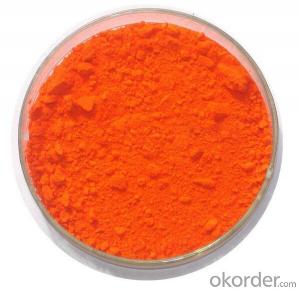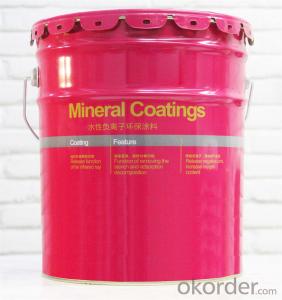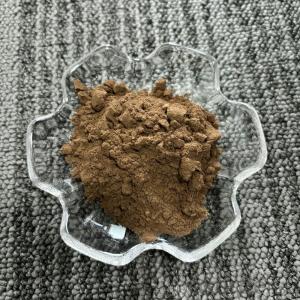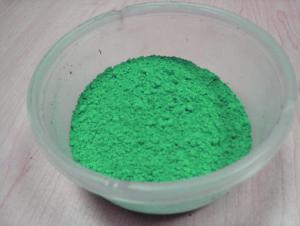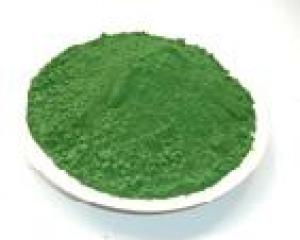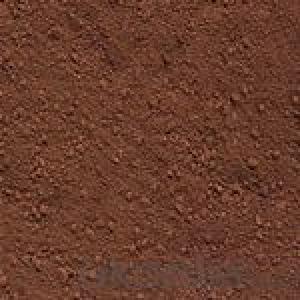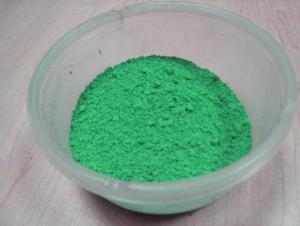Cadmium Orange Pigment Pigment Organic Powder
- Loading Port:
- Tianjin
- Payment Terms:
- TT OR LC
- Min Order Qty:
- 500 kg
- Supply Capability:
- 6000000 kg/month
OKorder Service Pledge
OKorder Financial Service
You Might Also Like
Cadmium Orange Specifications:
Products made by Powder Coating Pigments Manufacturer
- Excellent lightfastness resistance
- Weather resistance
- Tint strength
- Orange Pigment for Powder Description:
Chemical Name: Cadmium Orange
C.I.Name: Pigment orange 20
Chemical Components: Cd-Se-S
CAS No.: 12656-57-4
Cadmium Orange Main Technical Data:
Volatile content at 105℃: | ≤0.5% |
Soluble salts:
| ≤0.5% |
Residue on 325 mesh sieve: | ≤0.5% |
Features | The inclusion series is a kind of unpolluted pigment, compared with traditional Se. Red pigment, which is heat-resistant and high-colored. |
Usage | Mainly used in Tiles, Sanitary and Daily Ceramic producing, Offset Ink, Water base Ink , Textile Printing, Plastic etc.
|
Packing Details | 25kg/bag, 40bag/pallet, woven bag with inner plastic, or customized.
|
Delivery Time | 1-2 weeks after the confirmed order
|
Payment Term | L/C, T/T |
Cadmium Orange Advantages:
Non-flammable, non-corrosive, non-explosive.
Excellent coloring strength, good lightfastness, weather resistance, excellent hiding power and non-migratory, its’ color range from yellow through orange to purple reddish orange.
Cadmium Orange Applications:
Coating: Wall Coating, Powder Coating
Plastics: Masterbatch ,Engineering Plastics, PVC
Ceramics
Glass
Rubber



- Q:what are accessory pigments?
- Accessory pigments are light-absorbing compounds, found in photosynthetic organisms, that work in conjunction with chlorophyll a. They include other forms of this pigment, such as chlorophyll b in green algal and higher plant , while other algae may contain chlorophyll c or d. In addition, there are many non-chlorophyll accessory pigments, such as carotenoids or phycobiliproteins which also absorb light and transfer that light energy to photosystem chlorophyll. Some of these accessory pigments, particularly the carotenoids, also serve to absorb and dissipate excess light energy, or work as antioxidants. The different chlorophyll and non-chlorophyll pigments associated with the photosystems all have different absorption spectra, either because the spectra of the different chlorophyll pigments are modified by their local protein environment, or because the accessory pigments have intrinsic structural differences. The result is that, in vivo a composite absorption spectrum of all these pigments is broadened and flattened such that a wider range of visible and infrared radiation is absorbed by plants and algae. Most photosynthetic organisms do not absorb green light well, thus most remaining light under leaf canopies in forests or under water with abundant plankton is green, a spectral effect called the green window. Organisms such as some cyanobacteria and red algae contain accessory phycobiliproteins that absorb green light reaching these habitats. For more kindly click on the links below --- en.wikipedia.org/wiki/Accessory_p... en.wikipedia.org/wiki/Photosynthe...
- Q:What are the roles and type of plant pigments?
- Pigments are able to absorb specific wavelengths of light which power photosynthesis. Chlorophyll, which is green, absorbs all wavelengths except green. Each photon excites an electron in the light harvesting complexes of a photosystem in a chlorophyll molecule, eventually producing ATPs. Other pigments will be a different color and will be able to absorb other wavelengths, maximizing energy absorbency when the sun's rays change. Pigments are chemicals inside living things that absorb certain types of light. In plants, the pigment chlorophyll in leaves absorbs sunlight for photosynthesis to work, where the energy comes from. Chlorophyll absorbs all light except green, which is reflected. That's why most plants are green...
- Q:what are the differences between colorfast and non colorfast pigments?
- I'm sure with enough research you will be able to find these answers and explanations in your text book. Or google them, maybe it will have pics to help describe if your more of a hands on learner. Good Luck.
- Q:How do you use pigments?
- You can use Pigments for multiple things, eyes, cheeks and lips. -Eyes: With your clean fingers or with a small eyeshadow brush apply the pigment gently to your lids. If its a light color like white, apply it on the inner corner and under the brows. If its darker, like dark brown, apply it on the crease. You can also use it to line your eyes, I like to mix pigments with some moisturizer and with a really thin brush line my eyes. If its a matte pigment (with no shimmer or glitter) you can use it to fill in your brows. Lastly, you can use it on your lashes! I use some hair gel or clear mascara and I mix it with some pigments, I apply it with my finger or with an old mascara wand :) -Cheeks: Use it as a blush if its a pink, red, orange or coral color. Apply a small amount with a blush brush onto the apples of your cheeks. If its a white, very light brown or pink, use it as a highlighter. Apply with a small brush under you undereye area. If its a darker brown, use it as a bronzer or conturing powder. -Lips: Mix pigments with vaseline, olive oil or clear lipbalm to get a tinted gloss. If you want more precision, use a small brush to apply it. As you can see, Its all about the brush you use!! Hope it helped :)
- Q:What does pigment mean?
- The natural coloring matter
- Q:light absorption, which pigments are involved?
- All photosynthetic organisms contain one or more organic pigments capable of absorbing visible radiation, which will initiate the photochemical reactions of photosynthesis. The three major classes of pigments found in plants and algae are the chlorophylls, the carotenoids and the phycobilins. Carotenoids and phycobilins are called accessory pigments since the quanta (packets of light) absorbed by these pigments can be transferred to chlorophyll. Chlorophylls chlorophyll a - present in all higher plants and algae chlorophyll b - present in all higher plants and green algae chlorophyll c - diatoms and brown algae chlorophyll d - red algae (chlorophyll a is present in all photosynthetic organisms that evolve O2.) Chlorophyll molecules contain a porphyrin 'head' and a phytol 'tail'. The polar (water-soluble) head is made up of a tetrapyrrole ring and a magnesium ion complexed with the nitrogen atoms of the ring. The phytol tail extends into the lipid layer of the thylakoid membrane. Carotenoids (carotenes and xanthophylls) Carotenes: -carotene - higher plants and most algae $-carotene - most plants some algae xanthophylls: luteol, fucoxanthol and violaxanthol Carotenoids contain a conjugated double bond system of the polyene type (C-C=C-C=C). Energy absorbed by carotenoids may be transferred to chlorophyll a for photosynthesis. Phycobilins (found mostly in red and blur-green algae): phycoerythrin phycocyanin allophycocyanin )
- Q:What is the role of pigment in photosynthesis photosynthesis ?
- The pigment is known as chlrophyll, and plays a vital role in photosynthesis. It is a principal light-capturing pigment in most plants, algae and cyanobacteria. In plants and algae, chlorophyll is located in the thylakoid membranes of choroplasts. During the reaction of photosynthesis carbon dioxide and water produce energy using light energy trapped by the green pigment chlorophyll. This reactions primary products are ATP and NADPH, with oxygen being produced as a waste product. Photosynthesis takes place in the chloroplasts, where the green chlorophyll pigment is located.
- Q:What is better, Mac eye pigments or the regular eyeshadow? Also, has anyone tried the mixing medium solution?
- the pigments are awesome but the product is expensive
- Q:How are plant pigments involved in photosynthesis?
- Plant pigments - as other pigments - interact with light to absorb only certain wavelengths. In plants the different sorts of pigments are useful to absorb available wavelengths of light and enable photosynthesis in shadow, in bright sunshine, in deep sea etc.: each pigment reacts with only a narrow range of the spectrum, there is usually a need to produce several kinds of pigments, each of a different color, to capture as much as possible of the sun's energy.
- Q:What are MAC pigments?
- MAC pigments are similar to eyeshadow, except they are loose and in a small container instead of pressed tight into a palette. They're more pigmented (brighter, more vivid colors). This is Mac cosmetic's websites description: Pigment is a highly concentrated loose colour powder that contains ingredients to help it adhere to the skin. Create a subtle wash of colour or an intense effect. Does not streak or cake. It appears that all the colors they have available (online, at least) are frost finishes too, in case you were wondering that. :)
1. Manufacturer Overview |
|
|---|---|
| Location | |
| Year Established | |
| Annual Output Value | |
| Main Markets | |
| Company Certifications | |
2. Manufacturer Certificates |
|
|---|---|
| a) Certification Name | |
| Range | |
| Reference | |
| Validity Period | |
3. Manufacturer Capability |
|
|---|---|
| a)Trade Capacity | |
| Nearest Port | |
| Export Percentage | |
| No.of Employees in Trade Department | |
| Language Spoken: | |
| b)Factory Information | |
| Factory Size: | |
| No. of Production Lines | |
| Contract Manufacturing | |
| Product Price Range | |
Send your message to us
Cadmium Orange Pigment Pigment Organic Powder
- Loading Port:
- Tianjin
- Payment Terms:
- TT OR LC
- Min Order Qty:
- 500 kg
- Supply Capability:
- 6000000 kg/month
OKorder Service Pledge
OKorder Financial Service
Similar products
New products
Hot products
Related keywords
